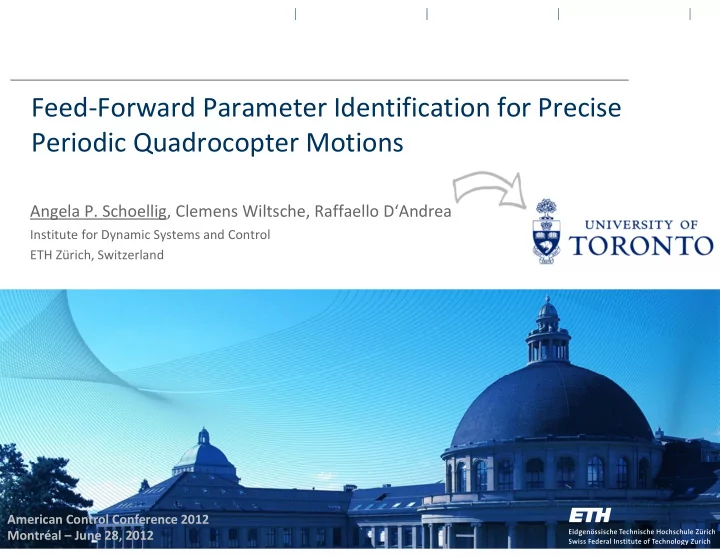

Feed ‐ Forward Parameter Identification for Precise Periodic Quadrocopter Motions Angela P. Schoellig, Clemens Wiltsche, Raffaello D‘Andrea Institute for Dynamic Systems and Control ETH Zürich, Switzerland American Control Conference 2012 1 Montréal – June 28, 2012
LET‘S DANCE Angela Schoellig ‐ ETH Zurich 2
... DANCE IN THE AIR VISION Dance performance of multiple aerial robots Angela Schoellig ‐ ETH Zurich 3
ACTORS STAGE Type: Quadrocopter Name: Flying Machine Arena Size: Ø 3 feet Size: 33 x 33 x 33 feet Weight: 1 pound Protection: Nets, Padded floor Flight time: 15 minutes Angela Schoellig ‐ ETH Zurich 4
TESTBED • cameras provide position and attitude • off ‐ board computer run controller • communication via radio module Autonomous flight. Angela Schoellig ‐ ETH Zurich 5
VIDEO: https://youtu.be/DrHlgxf0oQw?list=PLD6AAACCBFFE64AC5 Angela Schoellig ‐ ETH Zurich 6
FOCUS Music is pre ‐ processed. Motion is pre ‐ programmed. USER INTERFACE Music Analysis Vehicle Control Choreography Design Extract temporal Guide vehicle on desired trajectory Create dance ‐ like motions structure of the music • Trajectory following • Periodic motions piece • Motion ‐ music synchronization • Collision ‐ free transitions • Aerobatic motions Feasibility Check Is the choreography doable? Angela Schoellig ‐ ETH Zurich 7
FOCUS Music is pre ‐ processed. Motion is pre ‐ programmed. USER INTERFACE Music Analysis Vehicle Control Choreography Design Extract temporal Guide vehicle on desired trajectory Create dance ‐ like motions structure of the music • Trajectory following • Periodic motions piece • Motion ‐ music synchronization • Collision ‐ free transitions • Aerobatic motions Feasibility Check Is the choreography doable? Periodic motions = Basic elements of a rhythmic performance Angela Schoellig ‐ ETH Zurich 8
OBJECTIVE GOAL Precise tracking of periodic trajectories. Why? Rhythmic behavior, predictable and reliable performance. How? Rely on same trajectory following controller, adapt the parameter of the feed ‐ forward input. Desired periodic motion: Adaptation Trajectory Following Reference Signal Controller Desired position, velocity, acceleration Measured position and attitude Angela Schoellig ‐ ETH Zurich 9
APPROACH > 1D example Side ‐ to ‐ side motion. Nominal model. Control. Feedback linearization • Constant height Design linear controller • Translational dynamics 10
EXPERIMENT > 1D example Reference Signal Controller Result Constant phase shift and amplitude amplification Desired trajectory Actual motion 11
FEED ‐ FORWARD ADAPTATION > 1D example Reference Signal Controller 1) Online correction: Factors converge 2) Offline and online correction: Angela Schoellig ‐ ETH Zurich 12
RESULTS > 1D example Desired trajectory Actual motion ONLINE CORRECTION OFFLINE AND ONLINE CORRECTION IMPROVED TRANSIENT BEHAVIOR Angela Schoellig ‐ ETH Zurich 13
EXPERIMENTAL EVALUATION > 1D example Result Linear behavior. Steady ‐ state correction terms for various amplitudes . Steady ‐ state correction terms do not depend on motion amplitude. Angela Schoellig ‐ ETH Zurich 14
SUMMARY > 1D example Achieved high ‐ performance tracking without incurring transients by 1. Offline identification of steady ‐ state correction terms ‐ linear behavior: correction terms only depend on motion frequency ‐ prior to flight ‐ reduces transient behavior 2. Online correction for small non ‐ repetitive errors Reference Signal Controller Adaptation Angela Schoellig ‐ ETH Zurich 15
3D MOTIONS > main result Periodic motion primitives Decoupled directions. The correction values in each direction are independent of the other directions. Linear system behavior. The correction values of one direction depend only on the frequency of the motion component in this direction . Symmetry. The corrections in x ‐ and y ‐ direction are identical. Angela Schoellig ‐ ETH Zurich 16
3D MOTIONS > verification Circle in 3D Various 3D periodic motions executed multiple times, circles, swing motions, spirals, ... same amplitude COMPARABLE VARIANCES 17
REDUCED IDENTIFICATION SCHEME Strategy Perform one 3D motion over the relevant frequency range Result Using parameters from reduced identification Swing 3D Horizontal Circle Circle 3D 18
REDUCED IDENTIFICATION Strategy Perform one 3D motion over the relevant frequency range Result Using parameters from reduced identification 19
SUMMARY GOAL Precise tracking of periodic trajectories without transients. APPROACH Practicing prior to demonstration. • Adaptation of feed ‐ forward parameters A priori paramter identification through a small set of motions: • one motion per frequency is enough! Reference Signal Controller Adaptation Angela Schoellig ‐ ETH Zurich 20
LET‘S DANCE video: https://youtu.be/7r281vgfotg?list=PLD6AAACCBFFE64AC5 Angela Schoellig ‐ ETH Zurich 21
More: www.FlyingMachineArena.org Angela Schoellig ‐ ETH Zurich 22
Feed ‐ Forward Parameter Identification for Precise Periodic Quadrocopter Motions Angela P. Schoellig, Clemens Wiltsche, Raffaello D‘Andrea Institute for Dynamic Systems and Control ETH Zürich, Switzerland American Control Conference 2012 23 Montréal – June 28, 2012
Recommend
More recommend